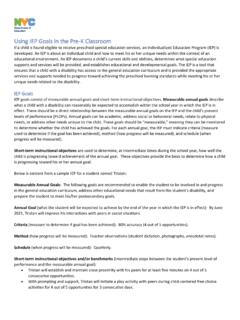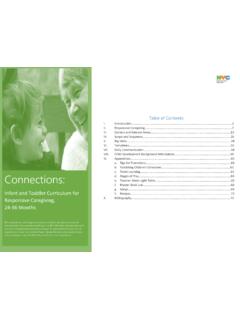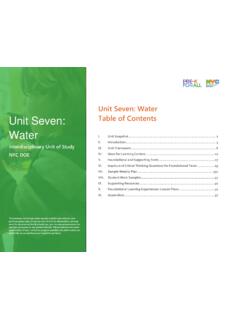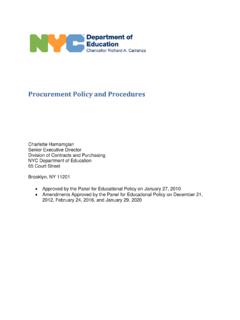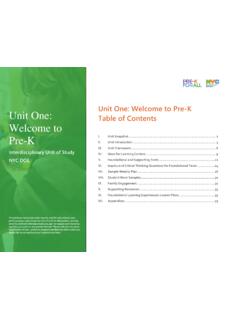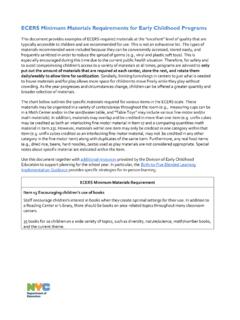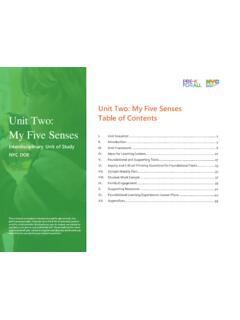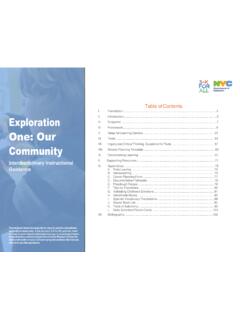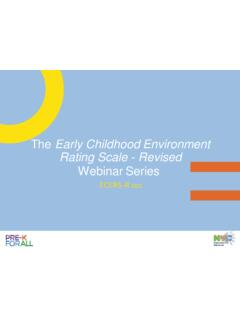Transcription of Unit 6 Light - infohub.nyced.org
1 unit Six: Light Table of Contents I. unit Snapshot .. 2 II. Introduction .. 4 III. unit Framework .. 6 IV. Ideas for Learning Centers .. 10 V. Foundational and Supporting Texts ..24 VI. Inquiry and Critical Thinking Questions for Foundational Texts .. 26 VII. Sample Weekly 29 VIII. Student Work Samples .. 35 IX. Supporting Resources .. 37 X. Foundational Learning Experiences: Lesson Plans .. 38 XI. Appendices ..54 unit Six: Light Interdisciplinary unit of Study NYC DOE The enclosed curriculum units may be used for educational, non-profit purposes only. If you are not a Pre-K for All provider, send an email to to request permission to use this curriculum or any portion thereof. Please indicate the name and location of your school or program and describe which units you would like to use and how you intend to use them. unit SNAPSHOT 2 I. unit Snapshot unit Topic: Light Essential Question How and why do we use different kinds of Light ?
2 Focus Questions What kinds of lights are around us? What is darkness? How does Light help us? What are shadows? Student Outcomes Enduring understandings that the student should have by the end of the unit : There are many types of lights in our homes and our cities. Light helps us see and stay warm. Light helps plants grow. When there is little or no Light it is dark. Shadows appear when an object blocks Light . Connected Academic Vocabulary This list should be adapted to fit the needs of individual programs and classrooms. battery blackout candle clouds curve dark day diurnal electricity eyes eyesight fire firefly flame flashlight grow heat horizontal lamp lantern Light Light bulb lightning lines melt mirror moon night nocturnal opaque outline parallel rainbow reflection see shade shadow sight silhouette solar power spiral stars straight street Light sun sunglasses traffic Light translucent transparent vertical wavy weather zigzag unit SNAPSHOT 3 Focus StandardsFrom the New York State Prekindergarten Learning Standards (NYSPLS) Domain 1: Approaches to Learning Approaches tasks and problems with creativity, imagination and/or willingness to try new experiences Domain 2: Physical Development and Health Uses senses to assist and guide learning.
3 Demonstrates coordination and control of large muscles Demonstrates awareness and understanding of safety rules Domain 3: Social and Emotional Development Recognizes self as an individual having unique abilities, characteristics, feelings and interests Domain 4: Communication, Language and Literacy Approaches to Communication Demonstrates a growing receptive vocabulary English Language Arts and Literacy Reading Foundations [ ] Demonstrates understanding of the organization and basic features of print Reading [ ] Participates in discussions about a text ( , during whole or small group interactive read-aloud discussions, during peer sharing, within play scenarios) Speaking and Listening [ ] Demonstrates command of the conventions of academic English grammar and usage when writing or speaking. [ ] Explores and discusses word relationships and word meanings Domain 5: Cognition and Knowledge of the World Mathematics [ ] Duplicates and extends simple patterns using concrete objects ( , what comes next?)
4 Science [P-PS3-1.] Participates in an investigation to determine the effect of sunlight on Earth s surface. Social Studies Demonstrates knowledge of the relationship between people, places, and regions The Arts [ ] Responds to Theatrical Arts INTRODUCTION 4 II. Introduction Welcome to unit 6: Light , Pre-K for All s sixth Interdisciplinary unit of Study. In unit 6: Light , children move from exploring various modes and aspects of transportation to inquiring and thinking critically about Light , darkness and shadows. This unit , like all Pre-K for All units, provides opportunities for children to observe objects and phenomena in their environment with increasing complexity. In this unit , children have the opportunity to deepen their understanding of natural and manufactured sources of Light . Activities throughout the unit prompt children to explore Light , darkness and shadows with hands-on materials as well as provide opportunities for children to make predictions and think about their world in increasingly abstract ways.
5 In Section IV: Ideas for Learning Centers, as well as throughout the unit , there are opportunities and examples of how children can use a Light table (a flat panel or table that has a backlit surface) in combination with other objects. Many classrooms will not have a Light table. See Section XI: Appendices for information on creating a Light table with recycled and/or easily attainable materials. We also recognize that in talking about Light and shadow, children may ask questions about people who do not see clearly. Please see Section XI: Appendices, for some guidance on how to discuss this with children. Most Interdisciplinary Units of Study are structured around four focus questions. Each focus question is designed to take about one week to explore. In the Light unit , children begin by considering the first question, What kinds of Light are around us? Children will observe, discuss and explore what they know about natural and manufactured Light .
6 In the second week, children will have learning experiences and explore activities that encourage them to think about darkness. In the third week, children focus on the question, How does Light help us? They will continue to consider the how Light affects our world, for example through conducting an experiment on growing plants in the Light and in the dark. In the final week, children explore shadows by using flashlights and other Light sources in the classroom as well as experimenting with shadows outside. Through these explorations, you are making science content and scientific thinking accessible and meaningful to children and building on their curiosity about science concepts. You are laying the foundation for continued scientific inquiry in Kindergarten and beyond. As we explore Light with prekindergarten children, it is important to keep in mind scientific information about Light , darkness and shadows. This background knowledge will help support your understanding as you guide children through the learning experiences in this unit .
7 For example, many children will notice that the moon shines at night; however, the moon actually reflects Light from the sun. We call sunlight white Light , but it is actually composed of many colors. Children may make observations that are scientifically inaccurate. We aim to support their observations and predictions while using our own background knowledge to ask questions that extend their thinking. Please explore the teacher resources in Section IX, or other accurate resources for background science knowledge on Light . We aim to support their (children s) observations and predictions while using our own background knowledge to ask questions that extend their thinking. Throughout this unit , there are opportunities to develop children s literacy skills. Children will enjoy literature, engage in discussions around stories, and retell and act out stories they have read. Children will build on what they know about Light , darkness, and shadows through informational texts.
8 They will explore vocabulary words such as silhouette and transparent to continue to develop their language skills as they engage in scientific explorations and thinking. In unit 5: Transportation, there were opportunities to focus on a few key letters and numbers that reflected the transportation modes that were relevant to your classroom. In this unit , we encourage you to highlight and help children explore the types of lines that form letters, numbers and shapes. You can use the Light table in the Writing Center to display various types of lines and for children to explore and look critically at lines, letters, numbers and shapes. Children can practice INTRODUCTION 5 forming the different types of lines that they observe through writing, painting, drawing, etc. As children explore shadows, there will be more opportunities to notice lines and shapes. Children will build their knowledge of letters, numbers and shapes as they explore these components.
9 unit FRAMEWORK 6 III. unit Framework Essential Question This is a child-friendly question that connects the knowledge and skills that children should develop throughout the unit . Focus Questions These represent the major inquiries of the unit . They build over time and require children to make connections across all content areas. Each focus question is designed to take about one week to explore. These are key components of each Pre-K for All unit of Study. Foundational Learning Experiences These are experiences ( , whole group, small group lessons, field trips, observations, center activities) for each subtopic that provide ample opportunities to deepen children s understanding of the Focus Questions. Foundational Texts [ ] Interacts with a variety of genres ( , storybooks, poems, songs) These are a combination of literary and informational texts that can be read throughout the unit . See Section XI for text-based critical thinking questions to support the read aloud experience.
10 Engaging, informative and literary texts provide opportunities for exploring content, expressing ideas using one s imagination and critical thinking that are enhanced through multiple readings of the same book. Reading books multiple times helps all children build a deeper understanding of content, make meaningful connections between content and other concepts or experiences and builds their confidence as learners and as future readers. Key Vocabulary These are academic vocabulary words that help children understand the unit focus questions and access complex texts. These words can be supplemented by vocabulary in read alouds. Family and Community Engagement These are ideas for inviting families to share their experience and knowledge with the class, or for extending learning outside of the classroom. They are aligned to the NYC DOE Division of Early Childhood education Early Childhood Framework for Quality (EFQ). See Section IX: Supporting Resources for more information about Family Engagement Practices.
